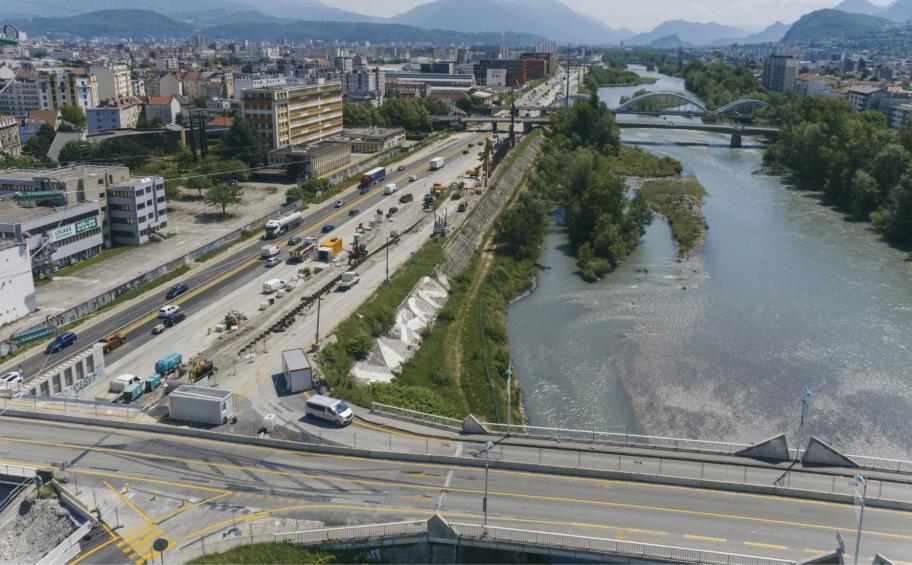Extending 15 km between the cities of Saint-Égrève (to the north) and Claix (to the south), the A480 is a motorway axis that passes through a large part of the agglomeration of Grenoble, principally serving local traffic and drivers changing roads between the A48, A41 via the south ring road and the A51.
Designed at the end of the 60s and opened during the Grenoble Olympic Games in 1968, this motorway is now used by close to 100,000 vehicles per day, making it one of the most saturated axes in France. An axis that, in its current configuration, no longer meets the mobility needs of the city's inhabitants. To remedy the situation, AREA is undertaking major redevelopment works that will continue until 2022.
An urban motorway is first and foremost an infrastructure that must blend into its environment. To do so, “it needs a very particular architectural treatment, quality landscaping and very specific installations to protect the environment and nearby residents,” explains Christophe Labbé, operations director (Dicodev) in charge of the A480-Rondeau redevelopment project.
“The motorways built in the 70s weren’t subject to the rules we have today. They generally didn’t have water or acoustic protection mechanisms. With our project, we plan to go further than current regulations, notably with the creation of a number of water treatment basins to treat water before it is discharged into the Drac or Isère, built under the carriageways so as not to take up further space.”
Until now, the A480 was fitted with 900 linear metres of acoustic protection screening up to the Mistral district and the Catane Bridge. In this project, there will be 6,000 metres, offering better urban integration and blending better into the landscape. Some noise barriers will be clad with drystone from local quarries, and partly covered in vegetation.
Another crucial notion for an urban motorway: improving traffic flow. “What’s important on this infrastructure isn’t fast travel, it’s the notion of “time planning”. Urban drivers generally don’t cover long distances, but they don’t want to waste precious time in traffic jams morning and night. They would prefer the reliable guarantee of a fixed journey time from point A to point B.”
It’s also important that this type of motorway contributes to preserving air quality. “Infrastructures snarled up from morning to night are a source of pollution,” adds Christophe Labbé. It’s better to have a reduced-speed structure. This was also one of the reasons the Préfecture wanted to limit speeds to 70 km/hr on the central section of the A480. Pollutant emissions are lower at 70 than at 90 km/hr.”
One of the other major challenges linked to the redevelopment of the A480 is to return it to being one of the backbones of the agglomeration. Christophe Labbé explains: “When the motorway is congested, this leads to an enormous volume of run-off traffic in Grenoble, particularly with today's navigation tools. Drivers following the directions of their GPS will sometimes find themselves leaving the A480 and taking the semi-pedestrianised streets of the city.” Another non-negligible problem: some boulevards in Grenoble are used by up to 40,000 vehicles a day. “This is far higher than the traffic on most of our motorways. Redeveloping the A480 will restore its capacity and allow vehicles to return to this motorway so that the transport axes in the heart of the city are relieved, and can be shared with pedestrians and cyclists and, more generally, other modes of soft transport.”
Lastly, to meet the criteria of an urban motorway well and truly part of its time, the A480 must also be “resilient”, concludes Christophe Labbé: “It must be able to adapt to future changes in terms of travel. As part of projects associated with new technologies, for example, we see the development and installation of Wifi terminals so as to detect incidents more easily and transmit more information to users.”
APRR-A480-mobilite-urbaine


A480, the urban motorway of the future
Grupa APRR
20 Jan - 14:49
8
In the process of redevelopment under the management of the APRR group, the A480, bordering the city of Grenoble (Isère), is the precursor to XXIst century urban motorways.
- Zaloguj się albo zarejestruj aby dodać komentarz
